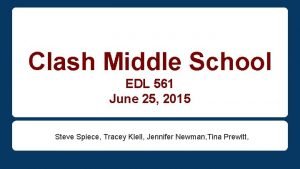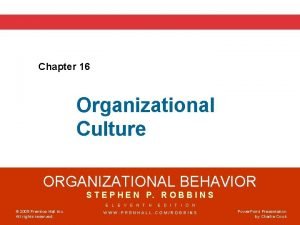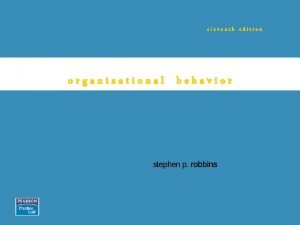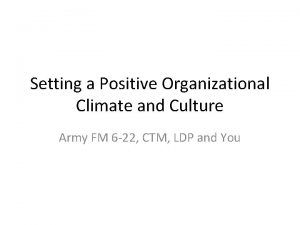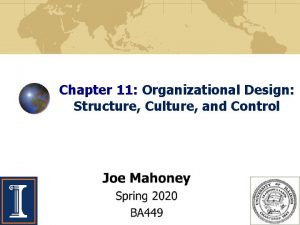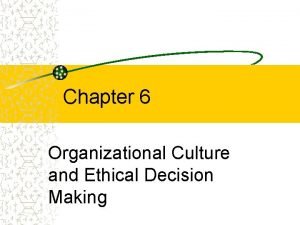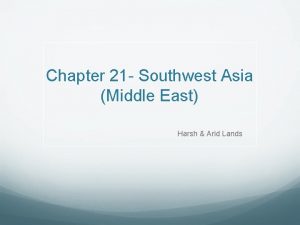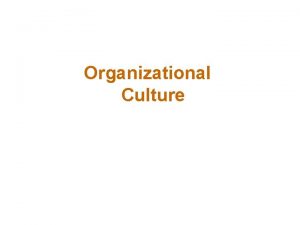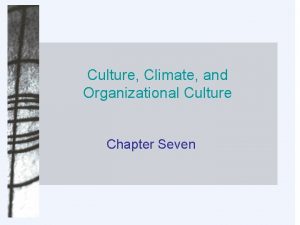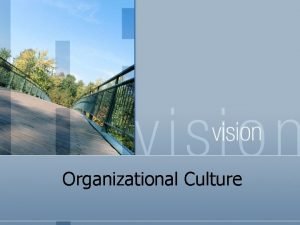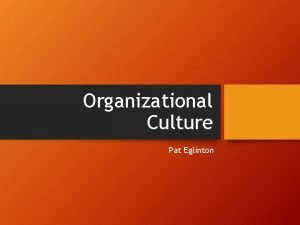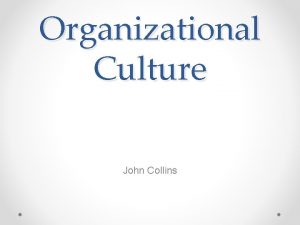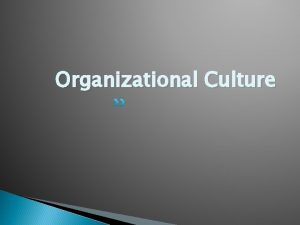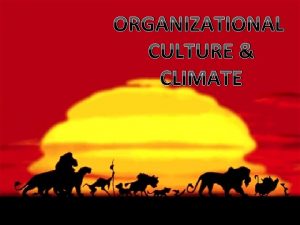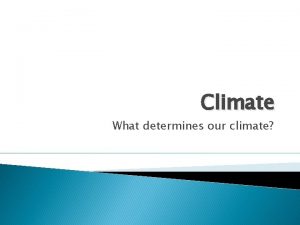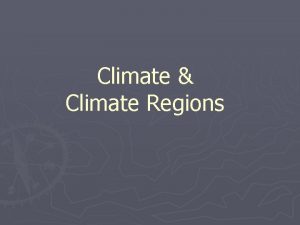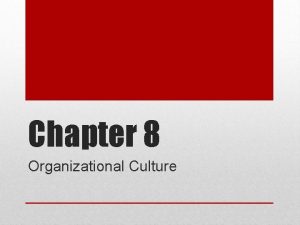CHAPTER 7 Organizational Culture and Organizational Climate Organizational

























- Slides: 25

CHAPTER 7: Organizational Culture and Organizational Climate Organizational Behavior in Education: Leadership and School Reform 11 th Edition Robert G. Owens Thomas C. Valesky

Theoretical Approaches • One can act through two theoretical approaches: – Classical Organizational or Traditional Bureaucratic. ○ Helps organize and manage the organization, but will not help motivate staff. – Human Resources Development (HRD). ○ Taps the higher order motivational needs of the people in the organization. Robert G. Owens and Thomas C. Valesky. Organizational Behavior in Education: Leadership and School Reform, 11 e. © 2015, 2011, 2007 by Pearson Education, Inc. All Rights Reserved 7 -2

Theoretical Approaches (continued) • HRD is concerned with how leaders structure the work environment to socialize individuals to the organization. This affects how individuals develop perceptions, values, and beliefs concerning the organization and what influence these inner states have on behavior. • This is the realm of organizational climate and organizational culture. • Important individuals in the development of the field: Kurt Lewin, Philip Selznick, Andrew Haplin, Don Croft, and Michael Rutter. Robert G. Owens and Thomas C. Valesky. Organizational Behavior in Education: Leadership and School Reform, 11 e. © 2015, 2011, 2007 by Pearson Education, Inc. All Rights Reserved 7 -3

Defining and Describing Organizational Culture and Climate • Different schools have distinct personalities due to the particular social system of each school. • This social system has a CLIMATE that is defined as the “characteristics of the total environments in a school building”. • Renato Tagiuri’s (1968) model identifies four elements that comprise climate. Robert G. Owens and Thomas C. Valesky. Organizational Behavior in Education: Leadership and School Reform, 11 e. © 2015, 2011, 2007 by Pearson Education, Inc. All Rights Reserved 7 -4

Defining and Describing Organizational Culture and Climate (continued) • Tagiuiri’s Model is composed of four dimensions: – Ecology. – Milieu. – Social System (Organization). – Culture. • See Figures 7. 1 through 7. 5. Robert G. Owens and Thomas C. Valesky. Organizational Behavior in Education: Leadership and School Reform, 11 e. © 2015, 2011, 2007 by Pearson Education, Inc. All Rights Reserved 7 -5

Importance of Organizational Culture • Theory Z: William Ouchi (1981). – Ouchi compared Japanese and U. S. management practices. – He applied Japanese practices in the U. S. and, using Mc. Gregor’s concept of Theory X and Y, called it Theory Z. – Theory Z accepts the concepts of human resources development. Robert G. Owens and Thomas C. Valesky. Organizational Behavior in Education: Leadership and School Reform, 11 e. © 2015, 2011, 2007 by Pearson Education, Inc. All Rights Reserved 7 -6

Importance of Organizational Culture (continued) • In Search of Excellence by Peters and Waterman (1982). – Research showed that successful organizations, including schools, had a consistent theme: “the power of values and culture in these corporations rather than procedures and control systems, provides the glue that holds them together, stimulates commitment to a common mission, and galvanizes the creativity and energy of their participants. ” Robert G. Owens and Thomas C. Valesky. Organizational Behavior in Education: Leadership and School Reform, 11 e. © 2015, 2011, 2007 by Pearson Education, Inc. All Rights Reserved 7 -7

Organizational Culture and Climate Compared and Contrasted • Culture “refers to the behavioral norms, assumptions, and beliefs of an organization. ” – “the way things are done around here”. • Climate “refers to perceptions of persons in the organization that reflect those norms, assumptions, and beliefs. ” Robert G. Owens and Thomas C. Valesky. Organizational Behavior in Education: Leadership and School Reform, 11 e. © 2015, 2011, 2007 by Pearson Education, Inc. All Rights Reserved 7 -8

Organizational Culture and Climate Compared and Contrasted (continued) • Critical theorists, such as Mc. Lauren (2007) expand upon the definition by including how a social group makes sense of its “given” circumstances and conditions of life. • According to Mc. Lauren, there is a dominant culture and a subordinate culture. – There are subcultures within both, frequently organized by class, gender, and race relations. – Need to give voice to the lived experiences of the subcultures to promote social justice and revolutionary multiculturalism. Robert G. Owens and Thomas C. Valesky. Organizational Behavior in Education: Leadership and School Reform, 11 e. © 2015, 2011, 2007 by Pearson Education, Inc. All Rights Reserved 7 -9

Organizational Culture and Climate Compared and Contrasted (continued) • Multiple cultures exist within an organization. – Subunits have distinctive attributes. – Subunits participate in many of the same culture-building things as the larger organization. – More likely to be accepted by Theory Y leaders. – Development of multiple cultures is facilitated by HRD and similar to Ouichi’s Theory Z. Robert G. Owens and Thomas C. Valesky. Organizational Behavior in Education: Leadership and School Reform, 11 e. © 2015, 2011, 2007 by Pearson Education, Inc. All Rights Reserved 7 -10

Organizational Culture and Climate Compared and Contrasted (continued) • Two major themes in a definition of organizational culture. – Norms: ○ Important way in which organizational culture influences behavior is through the norms or standards that the social system institutionalizes and enforces. – Assumptions: ○ Underneath these behavioral norms lie the assumptions that comprise the bedrock on which norms and all other aspects of culture are built. These assumptions deal with what the people in the organization accept as true in the world and what is false, what is sensible and what is absurd, what is possible and what is impossible. Robert G. Owens and Thomas C. Valesky. Organizational Behavior in Education: Leadership and School Reform, 11 e. © 2015, 2011, 2007 by Pearson Education, Inc. All Rights Reserved 7 -11

Organizational Culture and Climate Compared and Contrasted (continued) • Schein’s (1985) Model of Levels of Culture describes culture as: –A body of solutions to problems that is believed to be the correct method for perceiving & thinking about problems. – These solutions become assumptions about reality, truth, human relations, etc. – These assumptions become internalized and operate as a set of unconscious assumptions taken for granted. • These assumptions are manifest by artifacts and values that can be studied through qualitative methods. Robert G. Owens and Thomas C. Valesky. Organizational Behavior in Education: Leadership and School Reform, 11 e. © 2015, 2011, 2007 by Pearson Education, Inc. All Rights Reserved 7 -12

How Organizational Culture is Created • Culture is developed over time from: – An organization’s history, composed of traditions and rituals that are passed to succeeding generations. ○ Stories of heroes and heroines are important. – Values and beliefs that are embodied in the traditions and rituals. – Behavioral norms that result (e. g. , bell schedules, 7 -period day). Robert G. Owens and Thomas C. Valesky. Organizational Behavior in Education: Leadership and School Reform, 11 e. © 2015, 2011, 2007 by Pearson Education, Inc. All Rights Reserved 7 -13

How Organizational Culture is Created (continued) • Organizational on climate: culture has a powerful impact – Rosabeth Moss Kanter’s (1983) study of successful U. S. corporations. – High performers have a “culture of pride. ” – This is found in organizations that are integrative. – This culture fosters a climate of success. Robert G. Owens and Thomas C. Valesky. Organizational Behavior in Education: Leadership and School Reform, 11 e. © 2015, 2011, 2007 by Pearson Education, Inc. All Rights Reserved 7 -14

How Organizational Climate is Created • Organizational interaction of: climate is created by the dynamic – Ecology – Milieu – Organizational Structure – Culture ○ With perhaps culture being the most powerful determinant. ○ Roots of organizational culture are in Kurt Lewin’s work: B= f(p x e). • Example of the Carnegie Unit of Instruction impact on schools. Robert G. Owens and Thomas C. Valesky. Organizational Behavior in Education: Leadership and School Reform, 11 e. © 2015, 2011, 2007 by Pearson Education, Inc. All Rights Reserved 7 -15

How Organizational Climate is Created (continued) • Behavioral Settings: the complex physical and psychological environment of the organization in which individuals interact. • Examples: – Seymour Sarason’s (1972) The Culture of the School and the Problem of Change. ○ Must alter the patterns of activities, group norms, and the temporal qualities before hoping to change the impact on people. Robert G. Owens and Thomas C. Valesky. Organizational Behavior in Education: Leadership and School Reform, 11 e. © 2015, 2011, 2007 by Pearson Education, Inc. All Rights Reserved 7 -16

How Organizational Climate is Created (continued) • Interaction-Influence System is the central concept in Organizational Behavior. – The structure and processes of interactions among individuals is the interaction-influence system. • Interaction-Influence System includes: – Communication, motivation, leadership goals setting, decisions making, coordination, control and evaluation. ○ How these work in a school influence and shape behavior. ○ Describing organizations, therefore, is describing the interaction-influence system. Robert G. Owens and Thomas C. Valesky. Organizational Behavior in Education: Leadership and School Reform, 11 e. © 2015, 2011, 2007 by Pearson Education, Inc. All Rights Reserved 7 -17

Describing and Assessing Organizational Culture in Schools • Traditional researchers have trouble studying organizational culture because many elements are subtle, unseen, or self-evident to those involved. • Qualitative methods are often employed. – Epistemological concerns are often raised to the value of non-quantitative research. Robert G. Owens and Thomas C. Valesky. Organizational Behavior in Education: Leadership and School Reform, 11 e. © 2015, 2011, 2007 by Pearson Education, Inc. All Rights Reserved 7 -18

Describing and Assessing Organizational Culture in Schools (continued) • Organizational Climate is the study of the perceptions of the organizational environment. – Andrew Halpin and Don Croft (1962) studied leadership and group behavior in elementary schools. ○ Satisfaction is associated with climate. – Studies depend heavily on iliciting the perceptions of the participants. – Many studies now looking at students. Robert G. Owens and Thomas C. Valesky. Organizational Behavior in Education: Leadership and School Reform, 11 e. © 2015, 2011, 2007 by Pearson Education, Inc. All Rights Reserved 7 -19

Relationship Between Organizational Culture and Organizational Effectiveness • Rensis Likert’s analysis led him to conclude that there are causal variables under a leader’s control that affect climate and organization performance: – Organization structure: bureaucratic or flexible. – Leadership style: authoritative or democratic. – Philosophy of operation: consensus decision making or not. • The choices leaders makes are critical to determining the nature of the management system in the organization. That is, Likert’s System 1, 2, 3, or 4. Robert G. Owens and Thomas C. Valesky. Organizational Behavior in Education: Leadership and School Reform, 11 e. © 2015, 2011, 2007 by Pearson Education, Inc. All Rights Reserved 7 -20

Relationship Between Organizational Culture and Organizational Effectiveness (continued) • A study of 12 inner-city London schools found that changes in dependent variables of behavior, attendance, and achievement were due to: – the behavior of teachers at work, – the emphasis placed on academic performance, – the provision for students to be rewarded for succeeding, and – the extent to which students were able to take responsibility. • In other words, differences were due to organizational culture. Robert G. Owens and Thomas C. Valesky. Organizational Behavior in Education: Leadership and School Reform, 11 e. © 2015, 2011, 2007 by Pearson Education, Inc. All Rights Reserved 7 -21

Relationship Between Organizational Culture and Organizational Effectiveness (continued) • Measuring – Identifying variables. – Studies ○ Joyce School Effectiveness: independent and dependent by Epstein ○ Rudolf Moos • Findings from these type studies support the notion that many variables that can positively affect such outcomes as achievement and motivation of students are in control of leaders and teachers. Robert G. Owens and Thomas C. Valesky. Organizational Behavior in Education: Leadership and School Reform, 11 e. © 2015, 2011, 2007 by Pearson Education, Inc. All Rights Reserved 7 -22

Relationship Between Organizational Culture and Organizational Effectiveness (continued) • Research has shown a connection between school climate and organizational effectiveness. – Studies by Vishner, Emanuel and Teitelbaum (1999), Marzano (2003), and Voight, Austin, and Hanson (2013) revealed that effective schools: ○ Have high expectations for all students, ○ Maintain ○ Have ○ Are caring environments and relationships, meaningful participation for all stakeholders, perceived as safe environments, and ○ Foster a connectedness for all students. Robert G. Owens and Thomas C. Valesky. Organizational Behavior in Education: Leadership and School Reform, 11 e. © 2015, 2011, 2007 by Pearson Education, Inc. All Rights Reserved 7 -23

Voices from the Field • Changing the Culture, Making the Grade: Going from ‘F’ to Almost a ‘B. ’ – Kevin Gordon, Former Principal – Gibbs High School, St. Petersburg, Florida • Former alumnus hired to turn-around a failing school. • Worked to create discipline and academic plans through consensus – everyone on the same page. • Missed increase from ‘F’ to ‘B’ by six points. Robert G. Owens and Thomas C. Valesky. Organizational Behavior in Education: Leadership and School Reform, 11 e. © 2015, 2011, 2007 by Pearson Education, Inc. All Rights Reserved 7 -24

Four Management Systems • Each of Likert’s four management systems have identifiable organizational climates: – System 1: Exploitive-Authoritarian. – System 2: Benevolent Authoritative. – System 3: Consultative. – System 4: Participative Group. • Good communication requires effective use of the Linking-Pin concept. Robert G. Owens and Thomas C. Valesky. Organizational Behavior in Education: Leadership and School Reform, 11 e. © 2015, 2011, 2007 by Pearson Education, Inc. All Rights Reserved 7 -25
 Climate change 2014 mitigation of climate change
Climate change 2014 mitigation of climate change Edl positive school culture & climate
Edl positive school culture & climate Chapter 16 organizational culture
Chapter 16 organizational culture Customer responsive culture example
Customer responsive culture example Ethnocentrism examples
Ethnocentrism examples Continuous culture and batch culture
Continuous culture and batch culture Indian culture vs american culture
Indian culture vs american culture Stab and stroke culture
Stab and stroke culture Folk culture and popular culture venn diagram
Folk culture and popular culture venn diagram Folk culture and popular culture venn diagram
Folk culture and popular culture venn diagram Anaerobic media
Anaerobic media Homework due today
Homework due today Lawn culture method
Lawn culture method Lawn culture method
Lawn culture method Surface culture deep culture and esol
Surface culture deep culture and esol A positive organizational climate
A positive organizational climate Individual culture traits combine to form culture patterns.
Individual culture traits combine to form culture patterns. Batch culture vs continuous culture
Batch culture vs continuous culture Individualistic culture vs. collectivist culture
Individualistic culture vs. collectivist culture Sub culture group
Sub culture group Adaptive culture from inert culture
Adaptive culture from inert culture Characteristics of quality culture
Characteristics of quality culture Organizational design: structure, culture, and control
Organizational design: structure, culture, and control The role of corporate culture in ethical decision making
The role of corporate culture in ethical decision making Chapter 21 section 2 climate and vegetation
Chapter 21 section 2 climate and vegetation Chapter 21 section 2 climate and vegetation
Chapter 21 section 2 climate and vegetation

